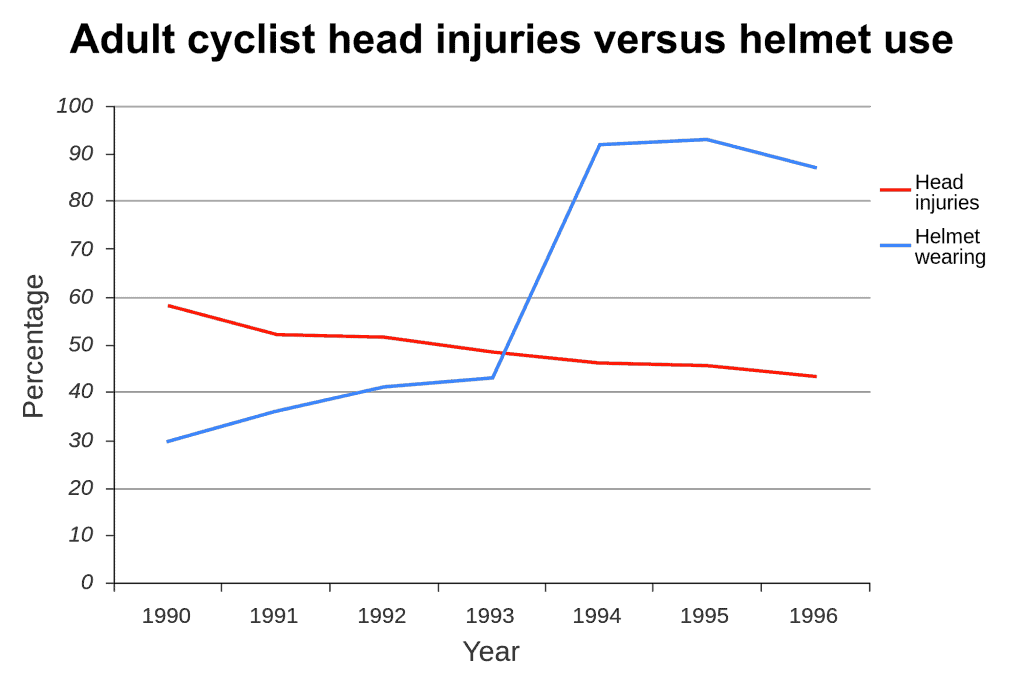A Canadian study, titled “Bicycling injury hospitalization rates in Canadian jurisdictions: analyses examining associations with helmet legislation and mode share” analyzed the link between cycling helmet legislation and recorded head injuries in various parts of the country. The findings put into question the efficacy of helmet legislation, and the researchers suggest that the best way to protect cyclists is for the government to provide infrastructure tailored to their needs.
The researchers crunched recorded hospitalization data from 2006 to 2011 for different Canadian jurisdictions, some with mandatory helmet laws, some without. For the average of 3690 riders aged 12 and over admitted for medical care per year (or 622 hospitalizations per 100 million bike trips) in Canada, the study found no evidence that helmet legislation reduces had any effect on the reported head injury rate.
The study also found that female had “consistently lower” rates of hospitalization for both transport and sport cycling than their male counterparts — which the authors attribute to their lower inclination towards risk taking behavior — and areas with more intense cycling traffic (defined as a greater proportion of trips) saw lower injury rates.
“Helmet legislation was not associated with reduced hospitalization rates for brain, head, scalp, skull or face injuries, indicating that factors other than helmet laws have more influence on injury rates,” the authors write.
The paper notes that bicycling injury research is “dominated by helmet research,” but while helmet use is undoubtedly associated with reduced odds of head injury in an accident, “studies examining the effect of helmet legislation have shown more mixed results”.
“We found that hospitalization rates for traffic-related injuries were lower with higher cycling mode shares, a ‘safety-in-numbers’ association consistent with results elsewhere and for other modes of travel.”
“These results suggest that transportation and health policymakers who aim to reduce bicycling injury rates in the population should focus on factors related to increased cycling mode share and female cycling choices. Bicycling routes designed to be physically separated from traffic or along quiet streets fit both these criteria and are associated with lower relative risks of injury,” they conclude.
Roger Geffen, Director of Policy at the Cyclists’ Touring Club sees this as further evidence that relying on helmets alone for cycling helmets is a loosing bet:
“Once again researchers have unearthed evidence which casts doubts on the usefulness of cycle helmets. They not only provided limited protection – they are only designed for minor falls, not collisions – but there is also evidence that they may increase the risk of collisions happening in the first place, by making either drivers or cyclists less cautious, or indeed by increasing the risks of neck and other injuries.”
“What’s clear though is that there’s no justification for health or safety professionals to bang on about cycle helmets as if they were a panacea. Their focus needs to be on reducing the risk of collisions occurring in the first place, by reducing traffic volumes and speeds, creating safe and cycle-friendly roads and junctions, tackling bad driving and reducing the risks from lorries. That’s what will help achieve more, as well as safer, cycling, in order to maximize the benefits cyclists gain from ‘safety in numbers’.”
While the study in no way suggests that helmets shouldn’t be used by cyclists, they advocate the development of safer, more specialized environments for cyclists, and the usage of helmets as a last resort — just as drivers rely on safety belts to save their life when everything else fails.
Hopefully we’ll see governments take steps towards this sooner, rather than later.










